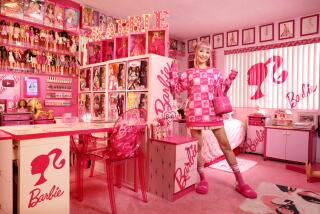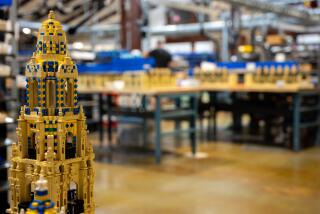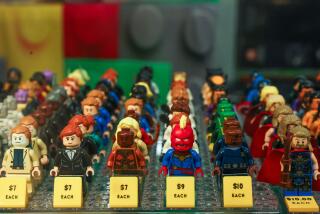For Legoland’s ‘Masters,’ Creating Displays Is Serious Business
- Share via
It’s every 9-year-old’s dream job. Get paid to play with Lego, with every brick ever made at your disposal. And that’s what Lego Master Builders do every day.
Visit master builders at their model shop at Legoland in Carlsbad, and you’ll find them working on a variety of projects from a 5-foot snake to a 12-foot octopus. These builders are responsible for building and maintaining all the models in the park, as well as making copies of models for use in retail stores and exhibitions.
It’s not child’s play. Miniland, the heart of Legoland, alone has 20 million Lego elements, forming reproductions of American landmarks from Washington to New York, San Francisco and the California coast. Add the life-size Darth Vader and R2D2, the giant dinosaur, and other life-size displays scattered throughout the park, and the demanding nature of the job should be clear.
Jetta Nielsen is a senior master model designer and mayor of Miniland. She starts her day at 5 a.m., checking all the models that have to stand up to the abuse of weather and thousands of eager park visitors each day. “We have to make sure everything is 100%,” she says. Maintenance is a big part of the job.
After several hours reviewing and repairing the Miniland display comes the fun part of the day, designing and building models. Modelers do the designs themselves, drawing on paper different angles of new concepts. These are often done freehand, or from pictures of real objects.
Each design is then translated by the builder into a scaled-down prototype made out of Lego bricks, and then a larger final model that is scaled up from the prototype and glued together brick by brick. The glue is not the white stuff of grade school, but an industrial adhesive that actually melts the bricks together.
A large model can take weeks or months to build, involve hundreds of thousands of bricks and weigh half a ton. One of Nielsen’s favorite and most challenging pieces is a 1:20 scale model of the Golden Gate Bridge. The bridge took 180 hours to complete and was done using only photographs of the real thing. Nielsen, a native of Denmark, had never visited San Francisco in person.
Model builders come from a variety of unusual backgrounds--they have been travel agents, pastry chefs, industrial designers and antique dealers. But even if you are Zack, the Legomaniac, Lego hiring managers are looking more for artistic ability than extensive knowledge of Lego bricks. All new builders have experience in art, usually sculpting or other 3-D design.
“It doesn’t have to be Lego you’ve been working with,” says Henrik Lykke, a Lego model supervisor in Carlsbad. “It’s a big help because you’re familiar with the brick, but it’s more important to be able to do proportions.”
Nielsen also emphasizes the importance of being able to visualize objects three-dimensionally. “You need to be able to work with the bricks as if they were clay,” she says.
A typical Lego candidate will bring a portfolio of work to an interview that includes drawings, designs for furniture, pictures of sculpture. And then, naturally, there’s a test. Generally this means being put in a room full of bricks for a few hours to build something on the spot--a recognizable bust of a famous person, for example.
The competition is fierce. When Lykke applied for the job in 1991, he was the one hire out of 800 hopefuls. Training for new recruits is no cinch either.
Lykke has supervised the training of many new hires, which involves several steps. First, trainees must copy exactly one of the smaller existing Miniland models, an 8-inch car for example. They must learn to “read” the bricks, Lykke says. This is especially important since Legoland does not keep records of exactly how each model is built--only pictures with general specifications such as size and weight.
Other learning projects include making models of people or cartoon characters, and globes, or other spherical shapes. “You need to get people thinking that they can build something circular using square objects,” Lykke says. These projects are also designed to familiarize new builders with the 6,500 different types of Lego bricks.
Lykke’s most notable project to date is a replica of Big Ben, built for Legoland Windsor outside London. Complete with moving hands and a chime, the structure stands 11.5 feet tall and is made of more than 200,000 bricks. To construct it, he spent several days in the library looking at pictures, took a trip to the real thing and spent six weeks designing and building.
It was very difficult because most people don’t know specifically what Big Ben looks like, but anyone can tell you if the proportions are off or it just looks wrong, he says.
The U.S. Capitol Building, which he designed and built for Legoland California, was actually built in six sections. Made of 370,176 bricks, the left and right sides are mirror images of each other.
As Lykke designed and built one side, another builder was copying the design for the other. The finished project was then shipped from the model shop in England to Carlsbad in sections, assembled and installed.
Despite the training and labor required, master builders agree that the work is every bit as fun as it seems.
Stephen Gerling has been a model designer for Lego since 1996. “Nobody will ever believe it’s a real job,” he says. “To kids, you’re like a rock star. There just could not be a cooler job. Most of their parents feel the same way.”
More to Read
Sign up for The Wild
We’ll help you find the best places to hike, bike and run, as well as the perfect silent spots for meditation and yoga.
You may occasionally receive promotional content from the Los Angeles Times.






